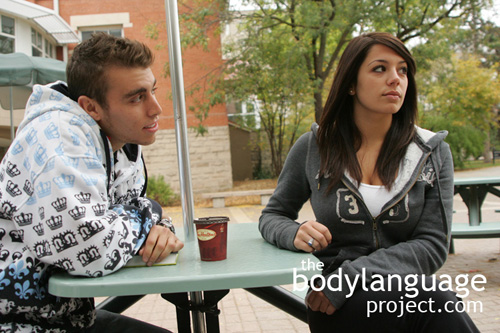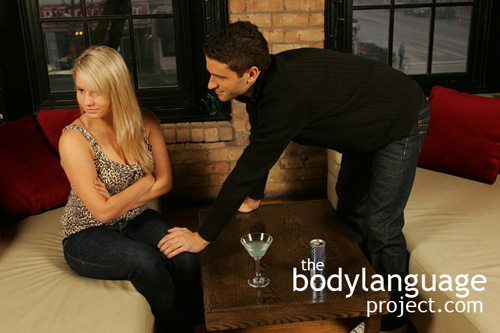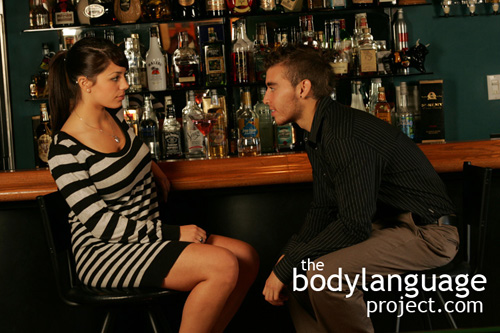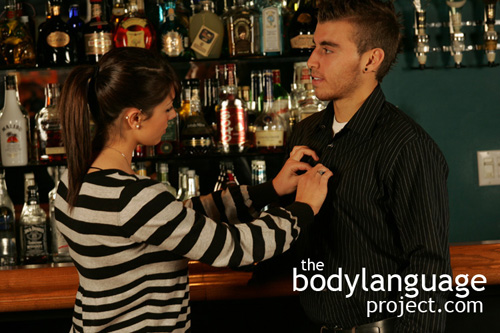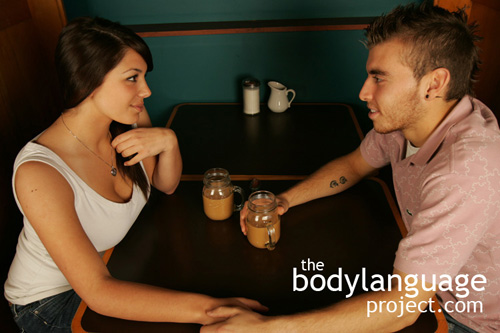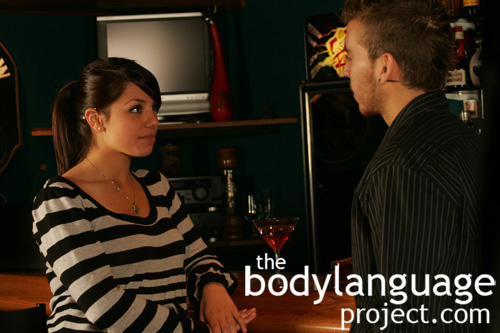Body Language of Loose Lips or Relaxed Lips
 Cue: Loose Lips or Relaxed Lips
Cue: Loose Lips or Relaxed Lips
Synonym(s): Relaxed Lips, Full Lips, Contented Lips, Plump Lips.
Description: When the lips are not stretched, compressed or pursed, curled or even smiling, the lips are full, relaxed, might be parted or just rested and plump.
In One Sentence: Lips that are full rather than compressed signal a relaxed and positive attitude.
How To Use it: Keep the lips relaxed to show others that you lack tension. Full lips that do not stretch across the face, but rather, are plump and loose, indicate a person who is happy and healthy.
Women can benefit best by showing full lips as they are associated with youthfulness, health and fertility. Lips are known to shrink as we age, so applying lipstick can help make them seem larger. Additionally, puckering them outward is a salient demonstrating of youthfulness and fertility. Benefits come to those with desirable features.
Puckering the lips outward rather than compressing them can also be used as a kiss indicator. To cue a kiss, or perform a “kiss-request,” woman simply need to puff out their lips while simultaneously looking at the lips of the man she desires.
Context: General.
Verbal Translation: a) “I’m so relaxed and content that my lips are full and not stretched or compressed because my entire body lacks tension and negative emotions.” b) “I’m happy and relaxed and feel no negative thoughts so my lips are not being stretched or compacted in any way.”
Variant: See Compressed Lips for the opposite cue.
Cue In Action: a) While reading a book, his lips parted, were full and lacked any tension. b) We knew she was relaxed when her lips fattened back up. She had been tense all day long, biting and compressing her lips as if they were being consumed.
Meaning and/or Motivation: People whose lips are loose show that they are sad, depressed or relaxed. Lacking any direct context or cue cluster, one should assume that loose lips are relaxed – the opposite to lip pursing. This nonverbal cue usually indicates true contentment but one should check for associated cues to decide with certainty.
The accompanying signals and facial expressions will decide which of the above emotions are being demonstrated. Relaxed body language is any body language that lacks muscle tension, the body is loose and the arms and legs move freely and naturally swaying with any motion. The torso may sag slightly to one side, or slump, but is not held by irregular tension. Thus, the body holds regular open body postures, with the arms and legs uncrossed. Breathing is steady and slow and can even become deep showing even more relaxation.
When the lips are loose and part, the head drops down and the eyes stare emptily it often signals contempt or disapproval in an “I can’t believe what I’m seeing.” However, in most cases, when the lips lack any tension it is due to being relaxed without negative feelings.
Cue Cluster: Expect to see an open face, palm up displays, torso oriented toward people, rather than away, legs uncrossed or if crossed then crossed toward, leaning in toward a speaker or leaning back and relaxed.
Body Language Category: Comfort body language, Liking, Honest body language, Liking, Nonthreatening body language, Open facial gestures, Relaxed body language.
Resources:
Arsenio, W. F., Cooperman, S., & Lover, A. Affective Predictors of Preschooler’s Aggression and Peer Acceptance: Direct and Indirect Effects. Developmental Psychology. 2000. 36: 438-448.
Carvajal, Fernando ; Rubio, Sandra ; Serrano, Juan ; Ríos-Lago, Marcos ; Alvarez-Linera, Juan ; Pacheco, Lara ; Martín, Pilar. Is a neutral expression also a neutral stimulus? A study with functional magnetic resonance. Experimental Brain Research, 2013. 228(4): 467-479.
Calvo, Manuel ; Fernández-Martín, Andrés. Can the eyes reveal a person’s emotions? Biasing role of the mouth expression. Motivation and Emotion. 2013. 37(1): 202-211.
Ekas, Naomi V. ; Haltigan, John D. ; Messinger, Daniel S. The Dynamic Still-Face Effect: Do Infants Decrease Bidding over Time when Parents Are Not Responsive?
Developmental Psychology. 2013. 49(6): 1027-1035.
Kraft, Tara L ; Pressman, Sarah D. Grin and Bear It. Psychological Science. 2012. 23(11): 1372-1378.
Mignault, Alain and Chaudhuri, Avi. The Many Faces of a Neutral Face: Head Tilt and Perception of Dominance and Emotion. Journal of Nonverbal Behavior. 2003 27(2): 111-132.
Matsumoto, David ; Hwang, Hyisung C. Desteno, David (editor). Judgments of Subtle Facial Expressions of Emotion. Emotion. 2014. 14(2): 349-357.
Navarro, Joe. 2008. What Every BODY is Saying: An Ex-FBI Agent’s Guide to Speed-Reading People. William Morrow Paperbacks.
Pinkham, Amy E. ; Brensinger, Colleen ; Kohler, Christian ; Gur, Raquel E. ; Gur, Ruben C. Actively paranoid patients with schizophrenia over attribute anger to neutral faces. Schizophrenia Research. 2011 125(2): 174-178.
Pell, Philip J. ; Richards, Anne. Cross-emotion facial expression aftereffects. Vision Research. 2011. 51(17): 1889-1896.
Roberson, Debi ; Kikutani, Mariko ; Doge, Paula ; Whitaker, Lydia ; Majid, Asifa. Shades of Emotion: What the Addition of Sunglasses or Masks to Faces Reveals about the Development of Facial Expression Processing. Cognition. 2012. 125(2): 195-206.
Shah, Rebecca ; Lewis, Michael. Locating the neutral expression in the facial-emotion space. Visual Cognition. 2003. 10(5): 549-566.
Tipples, Jason. Wide eyes and an open mouth enhance facial threat. Cognition & Emotion. 2007. 21(3): 535-557.
Teixeira Fiquer, Juliana; Paulo Sérgio Boggio and Clarice Gorenstein. Talking Bodies: Nonverbal Behavior in the Assessment of Depression Severity. Journal of Affective Disorders. 2013. 150: 1114-1119.
http://bodylanguageproject.com/articles/using-nonverbal-behaviour-to-assess-depression-severity/
Weisfeld, Glenn E. and Jody M. Beresford. Erectness of Posture as an Indicator of Dominance or Success in Humans. Motivation and Emotion. 1982. 6(2): 113-130.
http://bodylanguageproject.com/articles/body-language-cues-dominance-submission-children/
Woud, Marcella L. ; Becker, Eni S. ; Lange, Wolf – Gero ; Rinck, Mike. Effects of approach-avoidance training on implicit and explicit evaluations of neutral, angry, and smiling face stimuli.(Relationships & Communications). Psychological Reports. 2013. 113(1): 1211(18).
Vanderhasselt, Marie – Anne ; Kühn, Simone ; De Raedt, Rudi. Put on your poker face’: neural systems supporting the anticipation for expressive suppression and cognitive reappraisal. Social Cognitive and Affective Neuroscience. 2013 8(8): 903-910.
Wolf K, Mass R, Ingenbleek T, Kiefer F, Naber D et al. (2005) The facial pattern of disgust, appetence, excited joy and relaxed joy: an improved facial EMG study. Scand J Psychol 46: 403-409. doi: 10.1111/j.1467-9450.2005.00471.x. PubMed: 16179022.
Zeinstra, Gertrude G.; M.A. Koelen; D. Colindres ; F.J. Kok; C de Graaf. Facial Expressions in School-Aged Children are a Good Indicator of ‘Dislikes’, but not of ‘Likes.’ Food Quality and Preference. 2009. 20: 620-624.
http://bodylanguageproject.com/articles/read-kids-dislike-food-facial-expressions-accurate-detecting-dislike-not-like-children/

